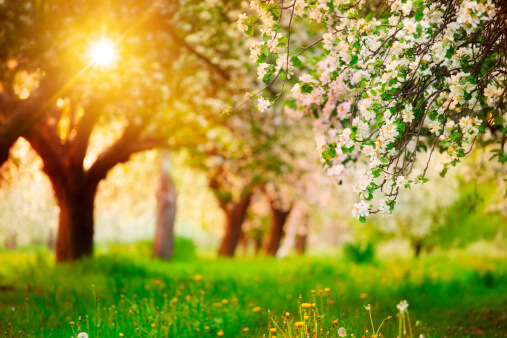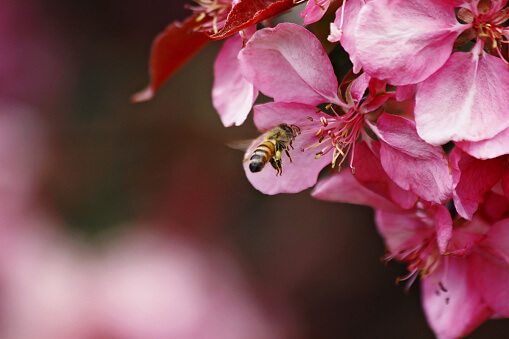
How Farmers are Supporting the Environment
How can the industry equip farmers with the tools they need to grow our food, while also preserving enough land and habitat for all species to thrive? Find out.

“Follow the bloom” is a common phrase in the commercial beekeeping community. Such a saying speaks to the wanderlust of caring for honey bee hives. The modern-day beekeeper lives part of the year on the road, traveling from state to state serving the many fruit, vegetable, and nut farms in need of honey bee pollination. This migration can take them thousands of miles across the United States in search of “blooming” crops and fields of sweet clover. Generally the first stop of this cross-country tour is the Golden State of California.
Many crops rely on honey bees, but few are more dependent than almonds.
Many crops rely on honey bees, but few are more dependent than almonds.
Every winter in the San Joaquin and Sacramento valleys, the largest pollination event in the world unfolds. By some estimates, over two million honey bees descend upon the pink and white colored almond blooms. The demand for pollinators is so great in this region, beekeepers at times have difficulty meeting the needs of every farmer. Sensing opportunity, apiaries from North Dakota, Texas, Florida, and the other forty seven states find their way to the Central Valley.
Consumer demand has turned this once obscure nut into a global commodity. Thanks to the service provided by these humble insects, California now provides 80 percent of the world's almond supply.
Consumer demand has turned this once obscure nut into a global commodity. Thanks to the service provided by these humble insects, California now provides 80 percent of the world's almond supply.
Depending on the crop, a farmer will order a certain number of hives for each acre. Almonds require two per acre, while pumpkins may need only a single hive for the same amount of land. After arriving on the farm, beekeepers place the hives along the fields and allow the insects to commence pollination. A prime example of working with the mastery of nature.
After weeks of pollinating almond fields, the journey must continue. Another crop is beginning to bloom…
After weeks of pollinating almond fields, the journey must continue. Another crop is beginning to bloom…
This partnership between farmers, beekeepers, and honey bees exemplifies the best of modern agriculture. Commercial colonies offer an irreplaceable service to farmers in exchange for access to pollen. Even within agriculture, this unique relationship between humanity and insects is something to behold.


This partnership between farmers, beekeepers, and honey bees exemplifies the best of modern agriculture. Commercial colonies offer an irreplaceable service to farmers in exchange for access to pollen. Even within agriculture, this unique relationship between humanity and insects is something to behold.
Beekeepers face challenges in every region. In some parts of the U.S., beehives can even attract a certain ferocious visitor.
Beekeepers face challenges in every region. In some parts of the U.S., beehives can even attract a certain ferocious visitor.
Another common destination for commercial hives is the eastern coast of Maine. Blueberry farmers in this region can see a thousand pound increase for every acre pollinated by honey bees. However, blueberry farmers are far from the only locals pleased with their arrival. Black bears in search of protein are known to find their way to hives and feast on young bees. To avoid this costly nuisance, some beekeepers surround their hives with electric fences to ward off hungry bears.
Other species may prove to be more efficient pollinators but none can match their ability to reproduce, adapt, and cooperate with each other.
Other species may prove to be more efficient pollinators but none can match their ability to reproduce, adapt, and cooperate with each other.
Moving a hive of insects from point A to point B is no simple task. The constructed hives need to be well-ventilated, have plenty of water, and minimize stress on pollinators. In many regards, beekeepers are providers of holistic care—tasked with monitoring the diet, medication, and overall health of each colony.
Moving a hive of insects from point A to point B is no simple task. The constructed hives need to be well-ventilated, have plenty of water, and minimize stress on pollinators. In many regards, beekeepers are providers of holistic care—tasked with monitoring the diet, medication, and overall health of each colony.
Florida is a popular destination for commercial hives. Thanks to the tropical climate, you can almost always find a crop in bloom and a farmer desiring the benefits of pollination. When April arrives, citrus farmers growing seeded grapefruit along the coastal towns of Florida are ready for pollinators.
Commercial beekeeping delivers 15 to 20 billion in economic value for agriculture each year.
Commercial beekeeping delivers 15 to 20 billion in economic value for agriculture each year.
After months of lengthy travel, both the beekeepers and their insect counterparts deserve a chance recharge. The many clover, canola, and sunflower fields of North and South Dakota offer needed sanctuary. In these weeks of roaming flower to flower, the bees influence the flavor profile of their honey. Over 300 varieties of the beloved nectar are sold in the United States—each with a different floral source. Following this respite are months of producing honey and beeswax.
Unlike the sweetness of honey, the lifestyle of beekeeping is an acquired taste.
For as much as six months a year, the men and women caring for pollinating honey bees spend their days traveling to various farms. This year-round endeavor requires an aptitude for business, entomology, logistics, and manual labor. Clearly, a particular makeup is required to withstand such a demanding, all-consuming profession.
For as much as six months a year, the men and women caring for pollinating honey bees spend their days traveling to various farms. This year-round endeavor requires an aptitude for business, entomology, logistics, and manual labor. Clearly, a particular makeup is required to withstand such a demanding, all-consuming profession.
Commercial beehives, with support from native pollinators, contribute to a more flavorful, visually appealing, and bountiful harvest. The process of pollination has evolved over millions of years, an ancient adaptation allowing plants to reproduce. Centering around pollen grains, this collaboration between plants and insects spreads the genetics to neighboring flora. Without this relationship many fruits, grains, and vegetables would be less available and accessible.
Maintaining biodiversity benefits the entire ecosystem, including humans.
Farmers and beekeepers are working alongside one another to ensure these critical insects thrive for generations. This may involve planting strips of wildflowers nearby to add more variety to the diet of honey bees, coordinating the application of insecticide to avoid incidental exposure, and advocating to find a solution to the most pervasive pest for North American colonies: the Varroa mite.
Related Articles

How can the industry equip farmers with the tools they need to grow our food, while also preserving enough land and habitat for all species to thrive? Find out.

Forward-thinking growers are using their land to provide habitat to pollinators, native plants, and other local wildlife. Learn how practices like cover crops, no-till, and crop rotation are demonstrating how a farm can be a positive influence on the environment.
